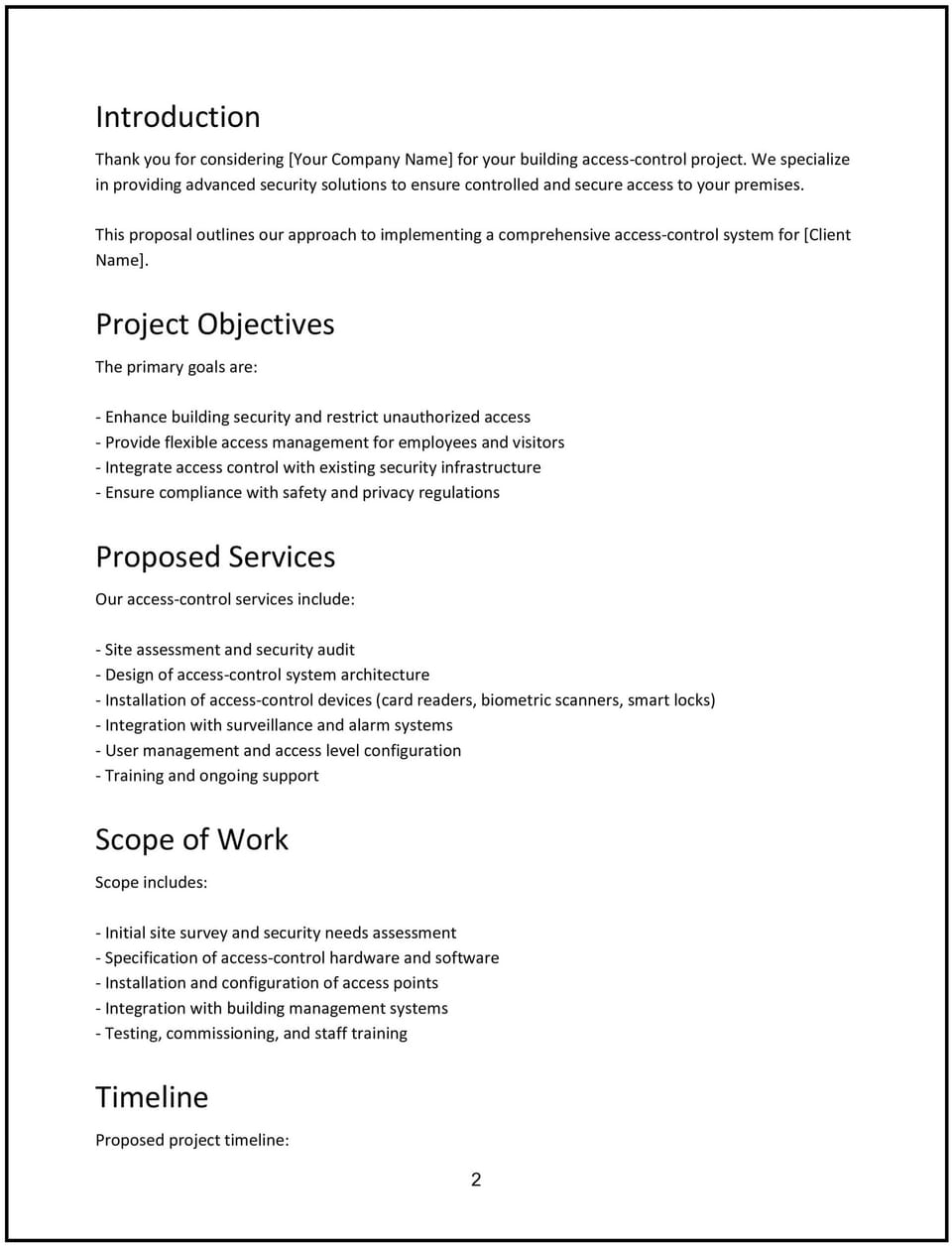Building access-control proposal: Free template

Customize this free building access-control proposal with Cobrief
Open this free building access-control proposal in Cobrief and start editing it instantly using AI. You can adjust the tone, structure, and content based on the building type, access needs, and security goals. You can also use AI to review your draft — spot gaps, tighten language, and improve clarity before sending.
Once you're done, send, download, or save the proposal in one click — no formatting or setup required.
This template is fully customizable and built for real-world use — ideal for pitching access-control solutions for office buildings, residential complexes, schools, warehouses, or public facilities. Whether you’re installing new hardware, upgrading software, or replacing manual systems, this version gives you a structured head start and removes the guesswork.
What is a building access-control proposal?
A building access-control proposal outlines your plan to install or upgrade systems that manage who can enter, exit, or move through a property. It typically includes a description of the current setup, recommended access-control methods, technology options, implementation plan, and pricing.
This type of proposal is commonly used:
- When a client needs to replace outdated keys or manual entry systems
- In response to security audits, compliance requirements, or tenant requests
- As part of a broader property modernization or risk management effort
It helps the client protect occupants, manage access, and streamline day-to-day operations with more control and less friction.
A strong proposal helps you:
- Translate security needs into simple system upgrades
- Set expectations around user training, hardware, and software
- Clarify installation logistics and compatibility with existing systems
- Position access control as both a security and operational improvement
Why use Cobrief to edit your proposal
Cobrief helps you go from draft to polished proposal quickly — with AI support built in and no formatting required.
- Edit the proposal directly in your browser: Start working instantly, no setup or downloads needed.
- Rewrite sections with AI: Tailor technical language, rephrase sections, or adjust the tone for property managers or security leads.
- Run a one-click AI review: Let AI catch unclear steps, overused phrases, or missing details.
- Apply AI suggestions instantly: Accept edits line by line or apply all changes in one click.
- Share or export instantly: Send your proposal through Cobrief or download a clean PDF or DOCX to deliver externally.
You’ll spend less time editing and more time winning work.
When to use this proposal
Use this building access-control proposal when:
- Pitching electronic or cloud-based access systems to replace manual keys
- Proposing fob, keycard, mobile app, or biometric entry systems
- Scoping access control for main doors, elevators, private areas, or gates
- Responding to a security review or recent incident that revealed gaps
- Pairing access upgrades with CCTV, intercom, or alarm integrations
It’s especially useful when the client wants to reduce risk while improving convenience for tenants, staff, or visitors.
What to include in a building access-control proposal
This template walks the client through the recommended upgrades, system benefits, and implementation steps — clearly and confidently.
- Project overview: Summarize the client’s current access challenges (e.g., lost keys, unauthorized entry, lack of audit trail) and how your system will address them.
- System components: List the hardware and software included — readers, control panels, door strikes, credential types, cloud platforms, or backup systems.
- Access levels and user management: Explain how user roles, entry zones, and permission groups will be created and managed.
- Integration and compatibility: Clarify how your system integrates with existing security infrastructure (e.g., alarms, cameras, intercoms).
- Implementation plan: Outline the phases — from site prep and installation to system testing and user onboarding.
- Training and support: Describe how you’ll train staff or tenants and what post-installation support is available.
- Timeline and milestones: Break down the project into stages with realistic timeframes for each.
- Pricing: Present clear pricing — by system, location, or user tier. Include optional add-ons like mobile access, remote monitoring, or 24/7 support.
- Next steps: End with a clear action — such as scheduling a walkthrough, confirming scope, or selecting a go-live date.
How to write an effective building access-control proposal
This proposal should feel reliable, practical, and aligned with both security goals and day-to-day building needs.
- Use clear, outcome-driven language: Focus on what the client gains — control, visibility, safety — not just hardware specs.
- Make tech feel approachable: Avoid overly technical terms unless the audience is technical.
- Be upfront about installation needs: Set realistic expectations for site access, downtime, and wiring or power requirements.
- Tailor based on building type: Commercial, residential, and public spaces all have different user needs and traffic patterns.
- Emphasize long-term manageability: Show how access control reduces admin workload and enhances oversight.
- Close with clarity: Don’t end vaguely — give the client one clear next step to move forward.
Frequently asked questions (FAQs)
Can I use this proposal for both small buildings and large facilities?
Yes — just scale the scope and system recommendations based on the size, number of access points, and complexity.
Does this proposal include remote or mobile access?
It can. You can include app-based credentials or cloud access platforms in your scope or as add-ons.
What if the client has existing infrastructure?
You can note in the proposal how your system integrates with or replaces current access or security components.
Can I include ongoing monitoring or maintenance?
Yes — you can offer post-install support, user management, or hardware service plans as optional items.
Is this proposal a contract?
No — it outlines your recommended scope, pricing, and process. A formal agreement can be attached separately.
This article contains general legal information and does not contain legal advice. Cobrief is not a law firm or a substitute for an attorney or law firm. The law is complex and changes often. For legal advice, please ask a lawyer.